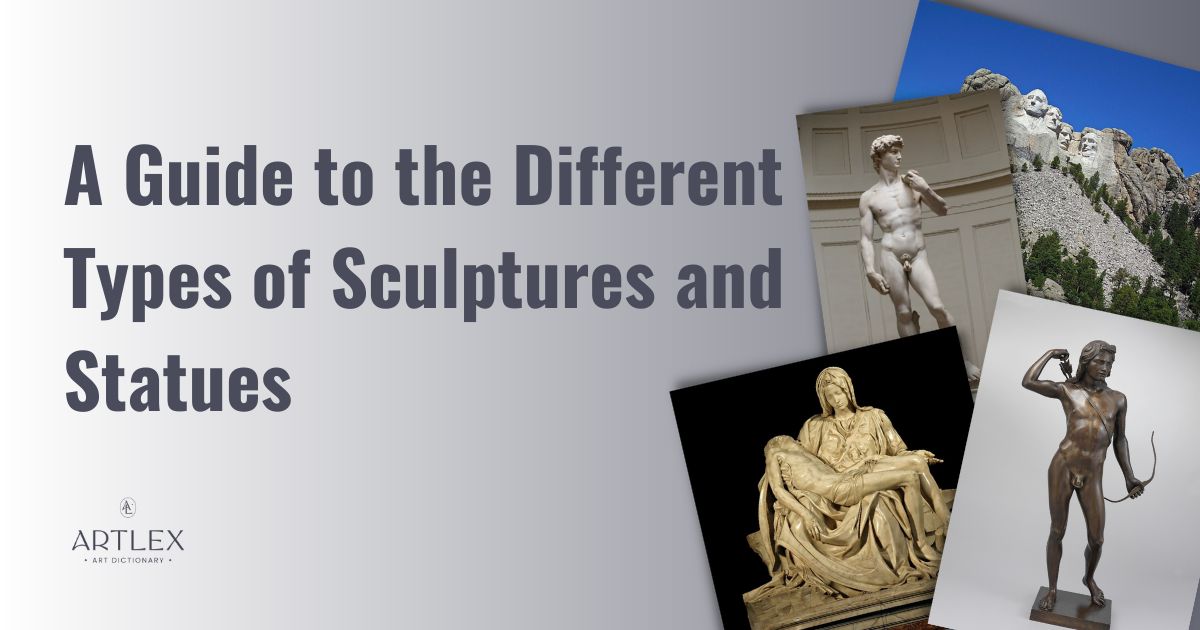
A sculpture is an art form where an artist carves or molds forms out of materials such as clay, stone, wood, or metal. In addition to using different materials, there are 11 different types of sculptures based on their characteristics and designs. Given this variety, sculptures and statues are great mediums for artists to express their creative abilities. Read more about the different types of sculptures and statues below:
What Are Sculptures?
Sculptures are three-dimensional forms created by the physical manipulation and placement of hard materials like clay, metal, concrete, glass, and plastic. Their forms vary but generally represent an emotion, a scene, or a topic.
Sculptures have been a part of human existence for as long as people have created art. While the creations may differ through time, the purpose and meaning behind the sculptures endure.
11 Types of Sculpture
The 11 types of sculpture are:
- Additive Sculpture
- Assembled Sculpture
- Cast Sculpture
- Carved Sculpture
- Earthwork Sculpture
- Installation Sculpture
- Kinetic Sculpture
- Modeled Sculpture
- Relief Sculpture
- Low Relief
- High Relief
- Sunken Relief
- Sculpture in the Round
- Subtraction Sculpture
Below we’ll look at the several types of sculptures, their most famous examples, and the materials each category uses:
Additive Sculpture
Additive sculpture is one of the types of sculpture that builds a sculpture from particular materials. Additive sculpture demands the artist to build a form by adding material to the work itself, contrary to the usual method of sculpting a particular type of medium and eliminating specific pieces of that material.
Additive sculptures are usually made from clay or wax, which can be easily shaped and joined to other parts. In addition to clay and wax, additive sculptures may be made with different materials such as paper, wood, or metalwork.
Modern artists can utilize a wide range of materials and processes to produce specific forms and structures, which has led to the increased use of additive sculpture.
Assembled Sculpture
Assembled sculptures are types of sculptures made from different materials and are put together to form a single piece. Artists from early times combined metal materials to produce various types of artwork.
Today, assembled sculptures are significantly more prevalent than in the early times. It gives the artists more freedom to create sculptures from almost any material they like. The assembled sculpture method is particularly popular among artists who seek to produce abstract works.
Materials used in assembled sculptures can be anything from wood to stone to metal, depending on what you want your sculpture to be made of. Depending on the type of assemblage you choose and how it’s constructed, assembling sculptures can be done differently.
One notable assembled sculpture is the Mechanischer Kopf (Der Geist Unserer Zeit) or The Mechanical Head (The Spirit of Our Time) by Raoul Hausmann. The objects used to create the artwork—a wooden head model originally used to make wigs—include a wooden ruler, a tape measure, a watch mechanism, and a tin cup.
Cast Sculpture
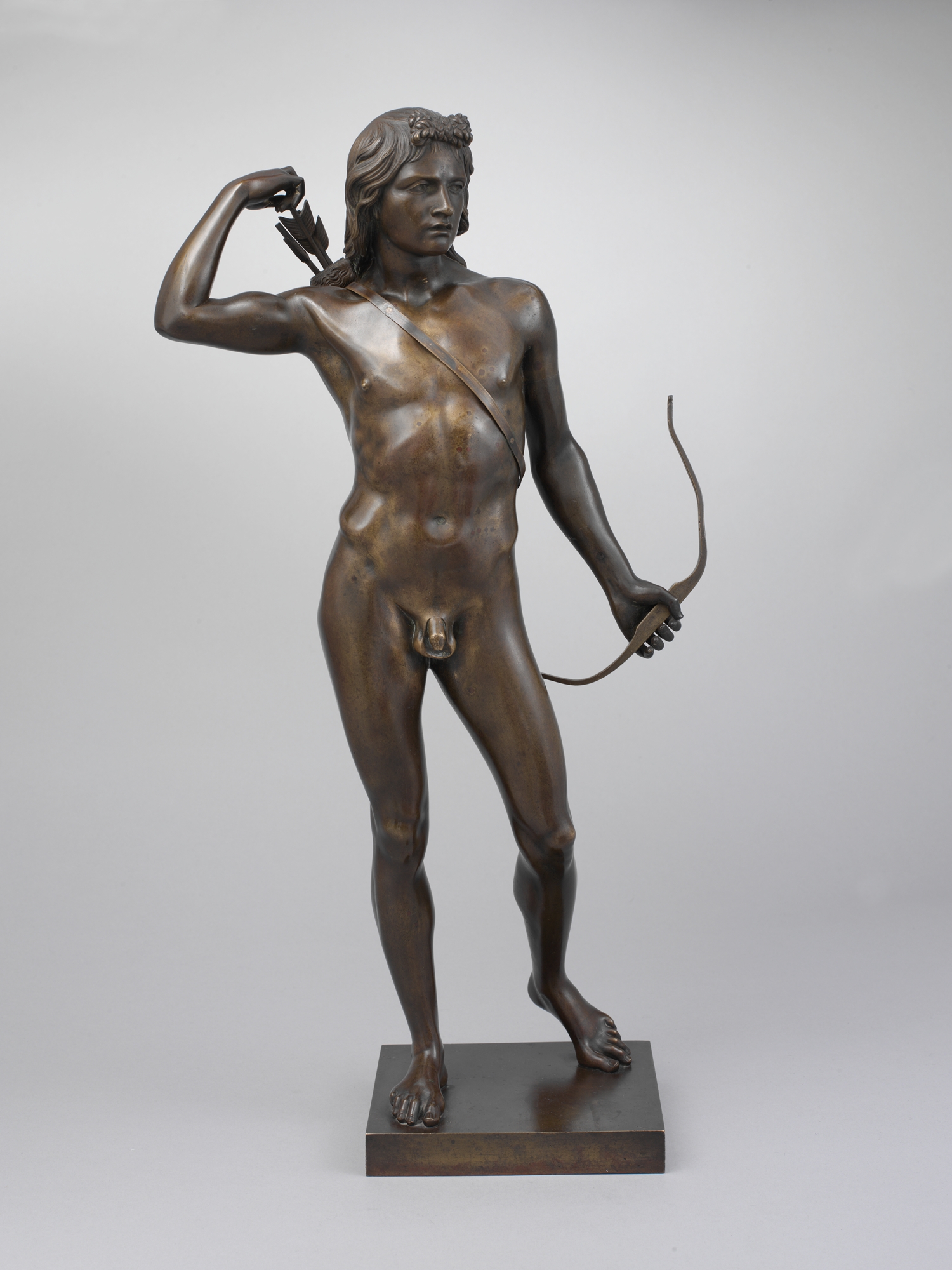
Casting is creating a sculpture by pouring liquid plaster into a mold. The mold is made of a material that can be removed from the sculpture after it has been cast, leaving behind only the masterpiece.
Cast sculpture origin can be traced back to early kinds of artwork that used materials like bronze or even clay. In the past, these materials frequently featured liquid metal, but today a plethora of various materials, including hard or plastic materials, fiberglass, and rubber, are used instead.
Choosing of the Arrow from 1849 by Henry Kirke Brown is one the best examples of cast sculpture made in bronze. It shows an idealized man in the naked state reaching to retrieve an arrow from the quiver fastened to his back.
Carved Sculpture
Carved sculptures are three-dimensional forms created by removing material from a solid medium. Carved sculptures are made of marble, wood, and ivory. The most common way to carve is with hand tools such as chisels and mallets.
To get the required figure, carvers must painstakingly labor to remove specific pieces of their material from their work. During early times, ancient cultures used carving to represent different animal species or natural phenomena and different religious figures that may have been used in ceremonial contexts.
Earthwork
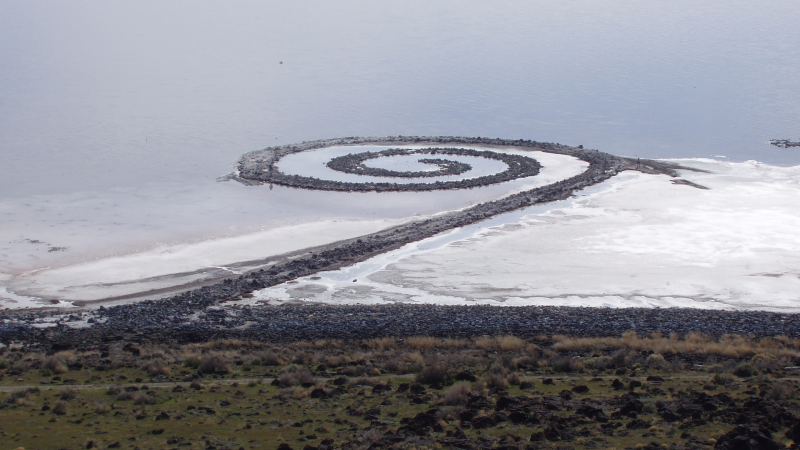
Earthwork sculptures are types of sculptures that are large-scale sculptures built in the landscape utilizing the ground or different kinds of wood or rocks. They may be created by people who live in the area, or they may be temporary or permanent works of art. Earthwork sculptures are a type of Earth Art/Land Art.
Early earthwork sculptures featured the creation of likenesses of specific animals or people, while other sculptures focused on particular shapes and patterns. Due to their large constructions, earthwork sculptures can be seen from an overhead viewpoint.
The earthwork sculpture Spiral Jetty, built in April 1970, is regarded as American artist Robert Smithson’s most significant creation. He made the art because he wanted to re-establish a connection with nature, which also reflected his passion for science and geology.
Installation
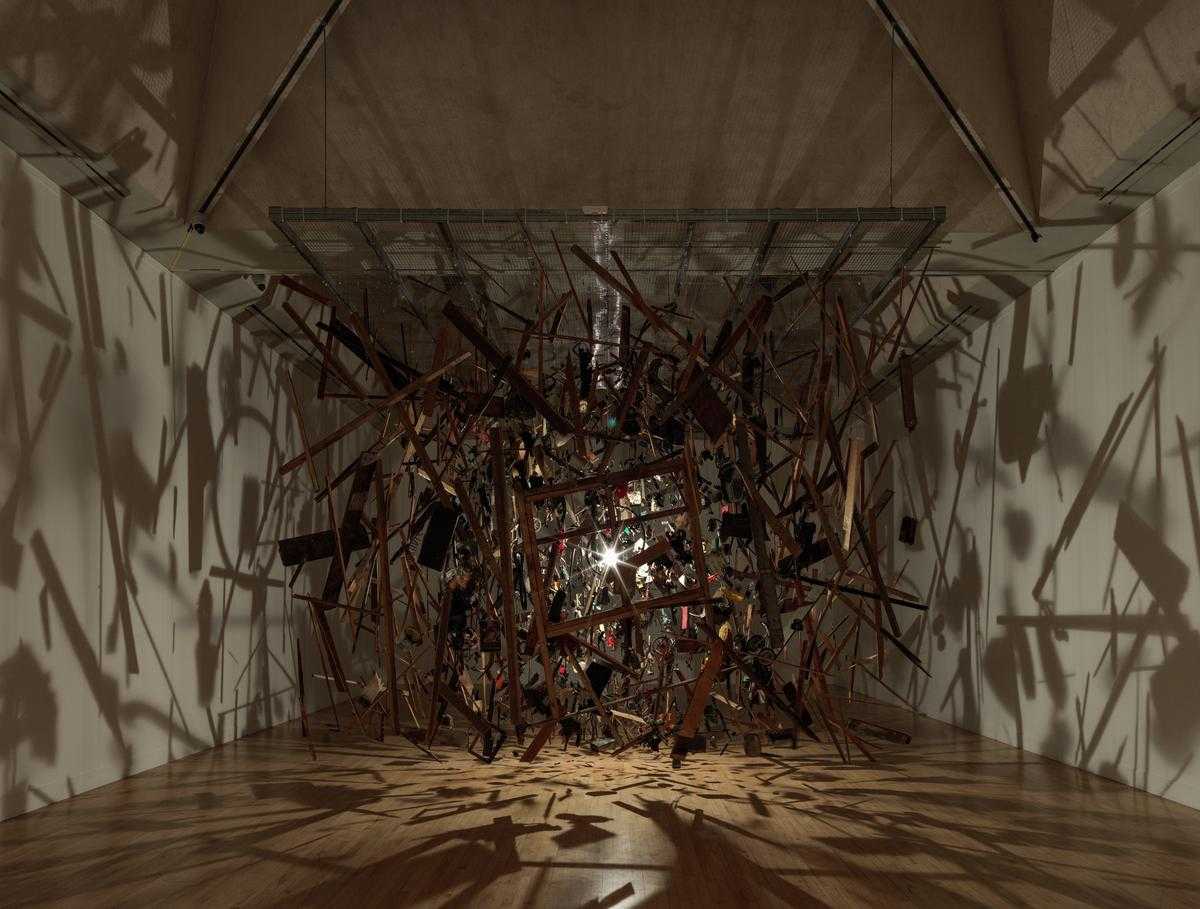
Installing various pre-formed elements together to make the finished sculpture is known as installation sculpture. These sculptures have three dimensions and can be produced from various materials, including wood, ceramics, and metal. A place or area is chosen for the creation of an installation sculpture.
When creating an installation, the artist must consider the space, context, and audience. Artists create an installation sculpture by hanging some parts of the artwork from the ceiling or securing them in place in various ways. Artists also use the idea of ‘site specificity’ – meaning they create work that references its location or environment in some way.
One of the best examples of installation sculpture in the modern period is British artist Cornelia Parker’s Cold Dark Matter: An Exploded View from 1991. The artwork is made up of the recovered items from a garden shed that the British Army blasted. Parker has assembled the parts into an installation suspended from the ceiling that appears to be held mid-explosion.
Kinetic Sculpture
Kinetic sculptures are art pieces that move or make a sound. Kinetic sculptures can also be called kinetic art. This kind of sculpture uses specific forms, curves, lines, and lighting effects to produce real or perceived contemporary art movements within the piece of sculpture or in the near vicinity. Moving mechanical devices or wind energy is used in kinetic sculpture.
The “About Face” kinetic sculpture by Anthony Howe, completed in 2017, is one of the best examples of a kinetic sculpture. It is created with weighted stainless steel panels that are free to swing in the wind and are individually balanced.
Modeled Sculpture
The modeled sculpture is sculpted by hand with clay, wax, or other materials. The majority of modeled sculptures are made by hand by the artist. However, more recently, different tools and even technology have been used.
The artist will model an object, person, animal, or scene in three dimensions and then use that model to create an enormous sculpture. Modeling is one of the oldest techniques used by artists to create sculptures. Modeling sculptures were utilized for artistic or religious purposes by various ancient cultures.
Relief
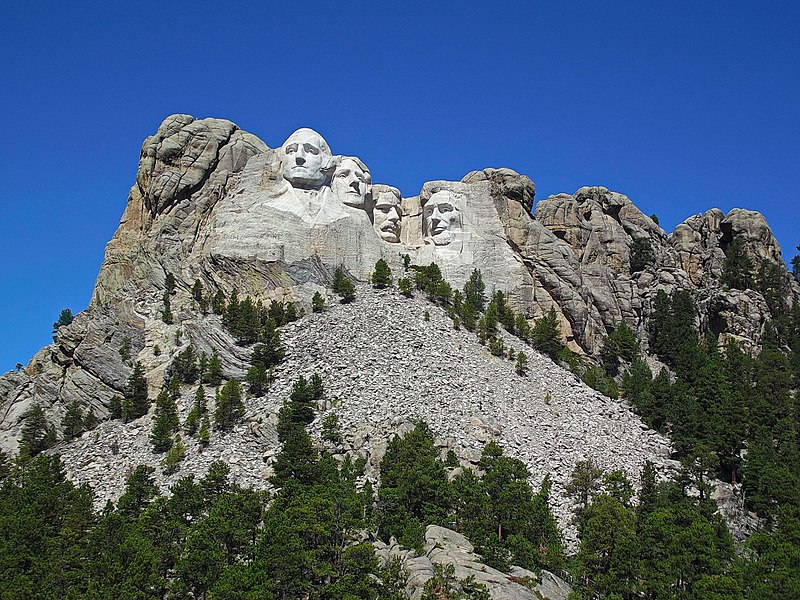
Relief is a type of sculpture with elements projecting from a flat background. Relief sculpture can be as essential as a light etching into the stone, wood, or other backdrop material or as intricate as most historical three-dimensional masterpieces.
The degree to which these forms of sculpture vary in depth distinguishes the various varieties of relief sculpture. The different types of relief sculptures are as follows.
Low Relief
Low relief sculptures have very little depth, which the artist exploited to make the sculpture. There is a considerably smaller chance that the artist may damage the sculpture by making this relief sculpture, which can be done on almost any surface.
High Relief
Sculptures in high relief have a greater degree of three-dimensionality than low relief or sunken relief sculpture styles. The use of high relief sculpture works was widespread thousands of years ago.
Ancient societies favored using them to embellish a variety of temples and other notable buildings. These pieces are frequently deeply cut and chiseled into the material.
Sunken Relief
The carving in sunken relief sculptures is done to indicate linear borders and contours on a mainly flat background. In contrast to low and high relief sculptures, the central figures in sunken relief works do not emerge from the main surface.
The sunken relief sculpture is referred to as “sunken” because the scene and the figures are levels with the background flat surface.
The Mount Rushmore National Memorial, created under the direction of Gutzon Borglum from 1927 to 1941, is the best-known and largest relief sculpture of the 20th century. The American Presidents George Washington, Thomas Jefferson, Abraham Lincoln, and Theodore Roosevelt are depicted in high relief sculpture in this extraordinary stone work.
Sculpture in the Round
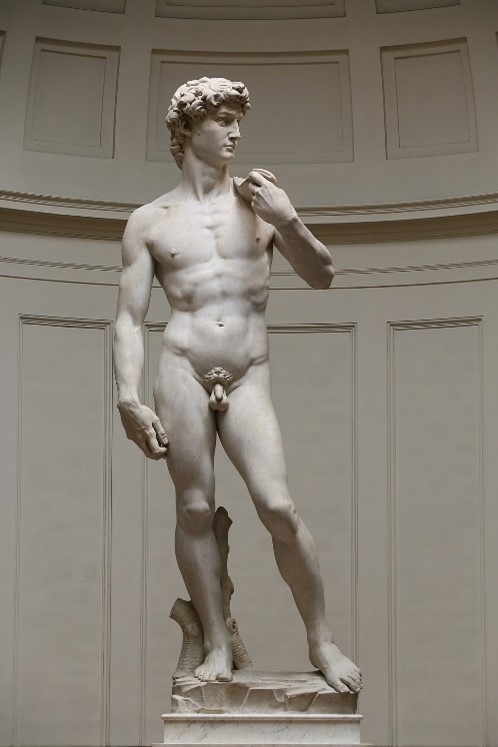
https://www.accademia.org/explore-museum/artworks/michelangelos-david/
A form of sculpture with a three-dimensional structure is a sculpture in the round. These sculptures can occasionally only be seen from one or two angles. Additionally, it grants the observer a complete viewpoint advantage.
While some sculptures may be free-standing, sculptures in the round are frequently intended to be viewed against a wall or specific type of background.
The Statue of David, created by Michelangelo between 1501 and 1504, is one of the most famous sculptures in the round in the history of art. It is 17 feet tall and made of marble. The Statue of David is an ideal representation of youthful beauty and symbolizes independence and strength for the city of Florence.
Subtractive Sculpture
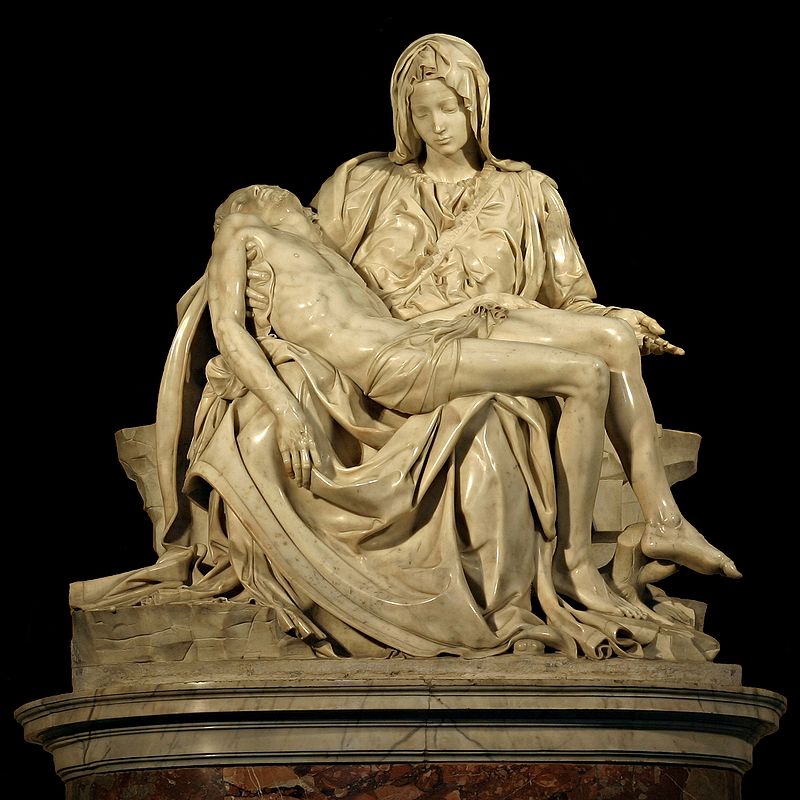
Subtractive sculpture is the removal of material from the medium. This type of sculpture resembles carved sculptures or works created in the round. Artists who make subtraction sculptures start with a piece of material whose shape corresponds to the final product.
Until the desired result is achieved, the artist will carve a piece of medium to carve their sculpture out of. It’s typical for artists to take away different elements of the medium or give previously existing shapes additional definition.
A classic of the Italian Renaissance, Michelangelo’s Pietà from 1497 is one of the most well-known pieces of art ever created and is considered a subtraction sculpture. It shows the lifeless body of Jesus after his crucifixion, lying on the lap of the Virgin Mary as she implores him in sorrow.
What Materials Are Used for Sculptures?
Sculptures are pieces of art that are made from different materials. The following are the most common materials used in sculpture:
Clay
Clay is a versatile material used to create sculptures, pottery, and many other art forms. It’s a soft material that can be shaped easily, making it a good choice for beginners.
The downside is that clay tends not to last long in outdoor environments and will need to be kept indoors or under cover if you want it preserved over time.
Wood
Wood is a material that’s been used to make sculptures for centuries. It’s easy to carve, chisel and sand and can be stained, painted, or left natural. Wood can be used to create small sculptures or large ones.
You can also use wood to create abstract or figurative pieces like people, animals, or buildings. If you like working with your hands while making something beautiful at the same time, wood may be a good choice.
Bronze
One of the most popular materials for sculptures is bronze. Bronze is an alloy of copper and tin. Due to its capacity to expand shortly before setting, bronze has traditionally been the favored metal for sculptures.
It’s durable and requires specialized casting methods that can be somewhat costly. Still, it’s also a great choice if you want your sculpture to last long without any noticeable tarnishing or discoloration.
Fiberglass
Fiberglass is a type of plastic that is strong, durable, lightweight, and can be molded into various shapes. It can be painted or stained to give it the look you’re going for.
Fiberglass sculptures are often used in making statues, busts, and other sculptures because they are easy to work with and durable enough to withstand being outdoors.
Plastic
Plastic is a relatively new sculpting material. It’s easy to work with and can be molded into many shapes. The most common plastics used in sculptures are polystyrene and polymethyl methacrylate, commonly known as acrylic.
These two types of plastic are often used in large outdoor sculptures and indoor installations because they’re light enough that the artist can easily install them without the help of heavy machinery or cranes.
Frequently Asked Questions about Sculpture
These are the frequently asked questions in the world of sculpting.
What is the most famous sculpture?
One of the most recognizable statues in the world, the Statue of Liberty is frequently used as a metaphor for both the United States and New York City.
It was given as a goodwill gift from the French to the Americans and is revered around the world as a representation of liberty and democracy.
Who are the most significant sculptors?
There have been renowned sculptors who have stood the test of time throughout history. Michelangelo of the Renaissance, Gian Lorenzo Bernini of the Baroque, Antonio Canova of neoclassical sculpture, and Auguste Rodin of modern sculpture are considered the most important sculptors of their era.
What is the difference between modern and postmodern sculptures?
Modern sculpture emphasizes elegance and simplicity, while postmodern sculpture focuses on an abstract and complex design. Modernism encourages logical reasoning, the application of science, and reason for the growth of humanity, whereas postmodernism holds that things are irrational.
Conclusion
A sculpture is a diverse art form found in many different types of media. It’s exciting to see how different types of sculpture have unique characteristics and meanings. Their impact on the contemporary sculpture world is undeniable and will continue to grow as time goes by.
Whether the art sculptures are meant to inspire, replicate or elevate a feeling, emotion, atmosphere, or energy in their viewers, they have successfully done what artists set out to do.
